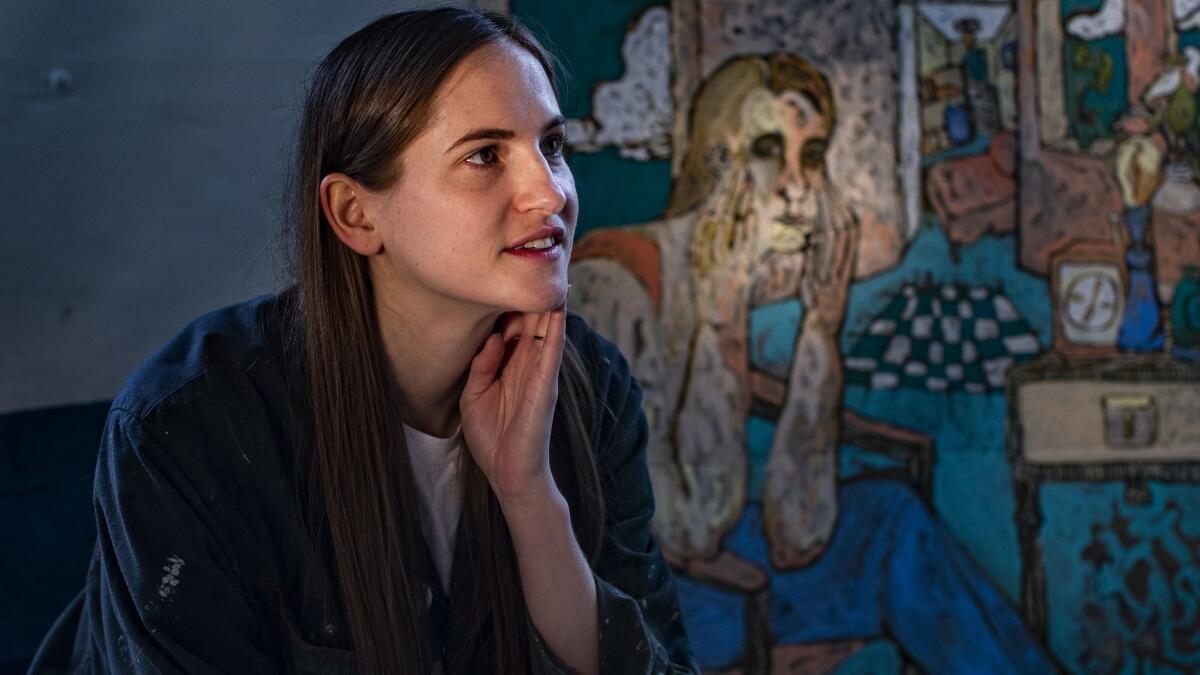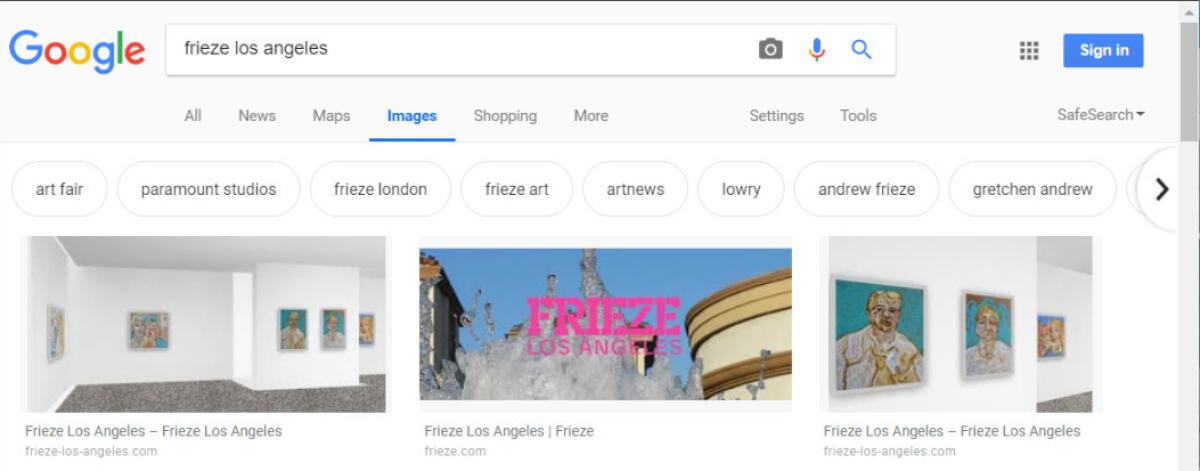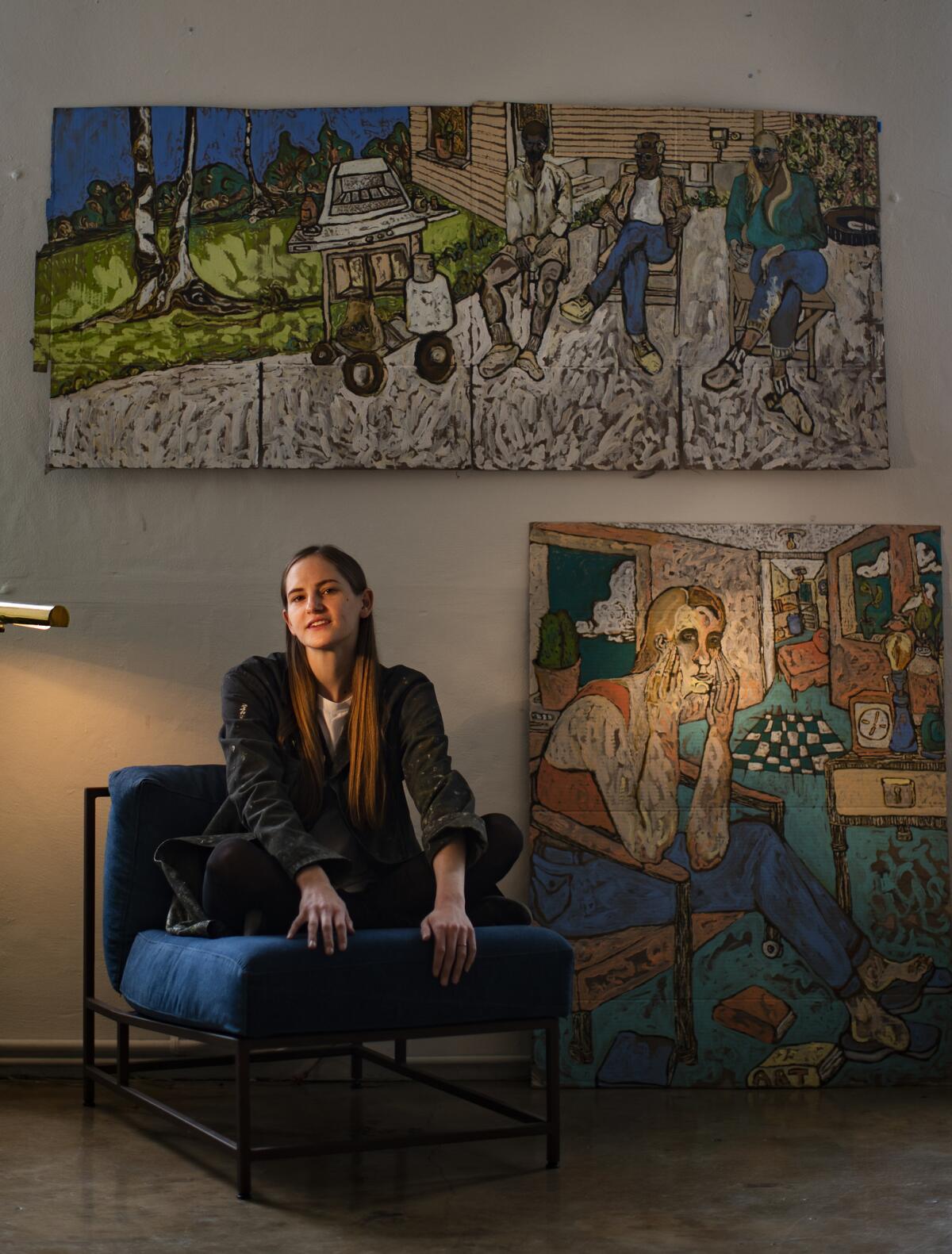Hack the Frieze Los Angeles art fair? This painter says she’s done it

Strewn across artist Gretchen Andrew’s coffee table in her downtown Los Angeles loft, little sample squares of gray and brown frieze-style carpeting serve as makeshift coasters for coffee mugs as well as conversation pieces.
Frieze may be the name of the major art fair inaugurating a Los Angeles edition this weekend, but it’s also a style of carpeting. Available in a variety of drab neutrals, its signature twisted fibers are designed to obscure footprints and vacuum track marks, Andrew says, running her fingertips across the pile of one sample.
Since October, Andrew has spent many hours populating websites like Quora, Pinterest, Yelp and Tumblr with her writings about frieze carpeting and images of her paintings displayed on the walls of a virtual gallery with a digitally generated frieze-covered floor. More important, Andrew has carefully optimized each post and image using basic search-engine-optimization strategies.
Her goal: Trick Google into displaying Andrew’s virtual gallery as the top image search result for “Frieze Los Angeles.”
The hack worked. Andrew may not be represented by a gallery, and her oil and charcoal portraits and figurative works on cardboard will not be displayed at Frieze Los Angeles, running Thursday through Sunday at Paramount Studios. But by using SEO techniques and a bit of clever word play about carpeting, she has convinced Google that images of her artwork are the most important visual content related to the much-hyped international art fair.
Google “Frieze Los Angeles” and click on “Images,” and you’ll likely find that more than half of the top 12 results displayed are of Andrew’s virtual gallery — and Andrew has successfully inserted herself and her artwork into the art fair’s online presence. (Frieze did not respond to a request for comment.)


It is a tactic — one that Andrew refers to as “digital performance,” “internet imperialism” or “search engine art” — that she has employed before. In previous iterations, Andrew used SEO practices to push images of her artwork into the top search results for “Made for Women,” “Powerful Person” and “Perfect Female Body,” among other phrases.
Using search engine optimization as an artistic medium comes naturally to Andrew. A former athlete from New Hampshire who attended Boston College on a track scholarship, Andrew studied information systems and worked in tech before leaving Silicon Valley to learn how to paint, first through YouTube videos and later as an apprentice of London-based figurative painter Billy Childish.
Despite two years as a Google employee, the artist says she doesn’t have any inside secrets when it comes to manipulating search results.
“I don’t know entirely how Google works,” she says. She says Frieze Los Angeles probably could push her out of the top spots if the art fair properly optimized its website, though it would take months for her images to disappear from results.
Clicking on one of Andrew’s images directs you to her “Frieze Los Angeles” website. The text on the page is meandering and nonsensical, designed to be read as much by search engines as by humans.
Excerpts of that same text appear in Andrew’s “Frieze Los Angeles Carpet Guide,” a newspaper the artist plans to distribute outside the fair this weekend. Like the paintings at the center of her work, the newspaper is a tangible, physical element of a largely ephemeral digital piece.

Andrew’s “Frieze Los Angeles” project is part of a larger body of art she expects to execute this year called “It’s My Future and I Want You There.” She says she plans to insert her images into search results for the Whitney Biennial and the Turner Prize.
Andrew says the series “very nonironically” explores her aspirations and dreams. The swirling, pastel figures she depicts in her paintings are of people, places and things she desires in her future. Similarly, the artist says that while she is critiquing powerful art world establishments, she is also poking a bear with which she’d one day like to be friends.
“I like these sort of insider-outsider dynamics,” she says. “I’m not so outside of the actual art world or so indifferent to it that I don’t respect these institutions. Essentially I am looking at the rules, the unwritten rules, and then finding creative ways to work around them, inserting myself in a fake-it-till-you-make-it way into the different echelons of the art world.”
THE FRIEZE INTERVIEW: Art fair organizers lay out their plans »
The dynamics of power and money in the art world and on the internet is a recurring theme in Andrew’s work. “There’s a big parallel between the way that the internet operates and the way the art world operates,” she says. “The internet has so much potential for creativity and connection but mostly is used as a place to buy things, spend money and create value for companies. That mirrors the art fair model. Art is this creative, liberating, inspiring aspect of our culture that also operates within this shopping mall dynamic of art fairs.”
At first, Andrew says she doesn’t think of herself as a disrupter, but then she backtracks.
“I guess I am disruptive by nature, but I’d like to think I am also conscientious by nature,” she says. “I’m thoughtfully disruptive, curious about rules (legal, technical) and where they leave room for creative play.”
Punking Google is a reminder, she says, that “technology often fails on nuance.” And if she can find ways to exploit that weakness, she says, it’s important to consider what those with real power and money can do.
Support our coverage of local artists and the local arts scene by becoming a digital subscriber.
See all of our latest arts news and reviews at latimes.com/arts.
The biggest entertainment stories
Get our big stories about Hollywood, film, television, music, arts, culture and more right in your inbox as soon as they publish.
You may occasionally receive promotional content from the Los Angeles Times.







